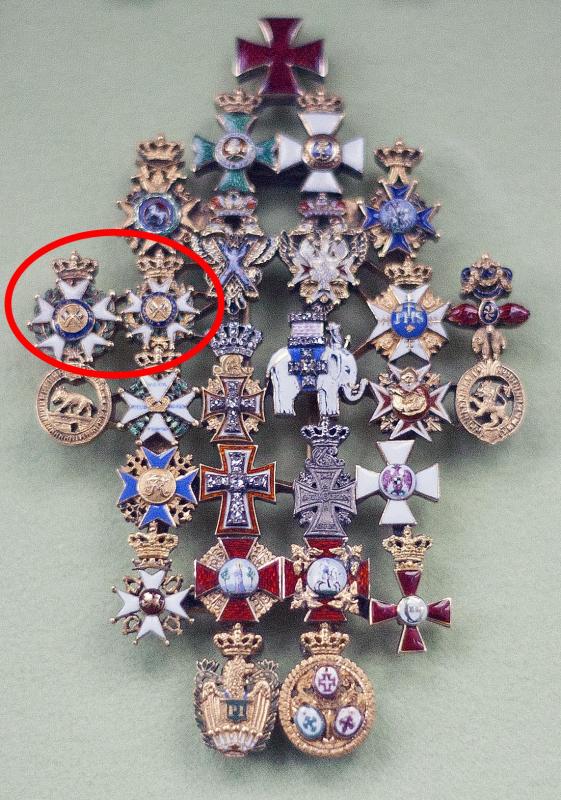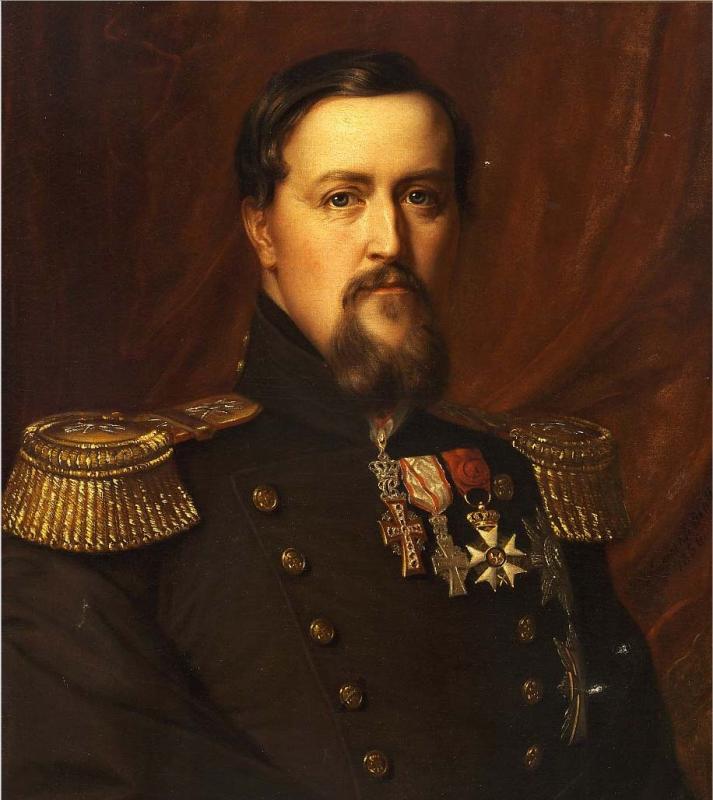-
Posts
1,211 -
Joined
-
Last visited
-
Days Won
8
Content Type
Profiles
Forums
Blogs
Gallery
Events
Store
Posts posted by Great Dane
-
-
-
Yes, it is quite impressive.
It is believed that he wore these miniatures at more private occasions - probably masonic (note the prominent placement of the Swedish (masonic) Order of Carl XIII at the top).
/Michael
0 -
Could it be that the explanation is the simple that kings (and other royalty) were exempt from normal rules and statutes and sometimes they just wanted something to fill the chest (preferably from favorite countries)?
I guess that is pretty much what you're hinting at, and it sounds plausible to me.
/Michael
0 -
Paul, I was ready to buy your explanation...
Frederik VII was known to like orders and medals (rumour has it that he on several occasions tried to get awarded the Danish medal for lifesaving by inventing various heroic deeds, but the requests were always turned down).
But then I found another photo. It's (one of) his miniatures and take a look at the left side - two versions of the Legion d'Honneur (one slightly bigger than the other).
For some strange reason they are showing the reverse, but that might be to not insult anybody as you mentioned.
/Michael
 0
0 -
Hi Paul,
Thanks for the input.
I was skeptical too, but then I got to look at some old pictures (not many photos exist from that era when photography was still young, so paintings are the next best thing).
Take a look at Frederik VII in the painting below - because he was a king, most of his decorations were Grand Crosses, and the only decorations he got to wear on his chest was:
- the Silver Merit Cross of the Order of Dannebrog (a special class that from the start was defined as both an independent (low) class of this order or an addition to those already decorated with the Dannebrog order)
- the Legion d'Honneur Officer class mentioned in my previous post
- later on in 1862 - the medal of the Swedish Order of the Sword.
I assume the painting is from approx. 1860, and it definitely seems like he is wearing the Officer class of the Legion d'Honneur, since the 3 decorations mentioned above are the only non-Grand Crosses he was awarded...
/Michael
 0
0 -
Hello Gents,
While I was researching the decorations of the Danish King Frederik VII (reigned 1848-1863), I came across something interesting regarding the French Legion d'Honneur.
He was awarded the Grand Cross of the order on July 25th, 1828, but was also awarded the Officer cross of the same order years later (probably around 1858).
It is specifically listed in my books that he was awarded the GC and the Officer cross, so I don't think it's a typo...
Note that I'm not talking about being 'promoted' within the order - the GC came first.
So my questions are:
- Was this common practice (GC + Officer to the same person)?
- What was the criteria/reason for the 'add-on' award?
I know that something similar can be seen for the Greek Order of the Redeemer (GC followed by Knight cross to the same person), but I don't know the details for this practice either.
/Michael
0 -
Not really... the book "Finlands Utmärkelsetecken" by Wrede doesn't say why it was awarded - he just describes what it looks like.
Here is a picture:
/Michael
0 -
Could the 8th ribbon be the Finnish "Skyddskårens förtjänstkors"?
It was awarded to foreigners...
/Michael
0 -
Hi Andreas,
The cypher in the centre dates it between 1882 and 1902.
/Michael
0 -
And I can add that he was awarded the Knight cross of Dannebrog on the 7th of February 1882, making it version with the King Christian IX cypher.
/Michael
0 -
Even without the statutes, you have been a great help!
Thnks so much, 922F

My reason for asking is, that I have this guy who - according to the Danish state- and court handbook (which of course could be wrong) - was awarded the 6th class of this order. I don't have his actual order, but I have his miniatures which contain a 4th class of the order (enameled rays and rosette on the ribbon).
So this mystery could either be vanity on his side or simply confusion...
/Michael
0 -
Thanks,
But I'm still confused...
As an example, take this website: http://www.royalark.net/Tunisia/orders.htm
Here is the description of the photo below (note that he calls 1. class "Superior class", 2. class is "1. class" etc.):
"Nishan al-Iftikhar, Type III - Fourth Class or Knight (Ali Bey) (L) and Fifth Class or Knight class II (Sadiq Bey) (R )."
http://gmic.co.uk/uploads/monthly_08_2014/post-769-0-40604000-1409267868.jpghttp://gmic.co.uk/uploads/monthly_08_2014/post-769-0-97796700-1409267868.jpg
To me they seem quite identical (apart from the monogram of course)...?
/Michael
0 -
Greetings all,
The Tunisian Nishan-i-Iftikhar (or Nishan Iftikhar) came in 6 classes (at least in the 1920-30s period), and I'm trying to figure out what the difference in appearance is between the two knight classes (5th and 6th class).
Class 4 (Officer) has red/green enamelled rays and a rosette on the ribbon, but class 5 (Knight I) and 6 (Knight II) both seem to be without enamel on the rays but still have green enamel on the center medallion.
I have looked in auction catalogs with pictures of 5th and 6th class, but they look completely identical!
Does anybody know what the difference is between 5th and 6th class?
/Michael
0 -
Not my area, but always interested in good research.
For 50 Euros I'll buy one.
/Michael
0 -
Great research! Congratulations!
I often find that the research part of our hobby is as challenging and enjoyable as the collecting

/Michael
0 -
Sometimes the red flag with the red cross is also used in Italy (Savoy?), but it seems that this badge is Danish as "A/S" normally means "Aktieselskab" (as in a public company - same as "AG" Aktiengesellschaft in Germany).
But I have never seen this badge before or even heard of a company called DFSS A/S...
It looks really interesting!
/Michael
0 -
One small correction:
It is actually called "Dannebrogsmændenes Hæderstegn" (the name was changed to "Dannebrogordenens Hæderstegn" i the 1950s with some changes in the statutes as well).
/Michael
0 -
Hi Andreas,
Nice purchase. You are right in ID'ing it. Awarded during the reign of King Frederik VII (1848-1863).
The only lists of recipients are the various Court- and State Handbooks (Hof- og Statskalenderen), but they are not 100% accurate (e.g. if a recipient received the award and then died in between two volumes of the handbook, he wouldn't be in there).
Unfortunately I don't have my handbooks at hand...
A lot of these 'Hæderstegn' were awarded for the first Danish-Prussian war 1848-50 to NCOs and lower ranks (mostly due to a lack of other decorations - officers would receive the knight cross).
And of course, the miniatures were a private purchase.
/Michael
0 -
Did a little more research...
Definitely not from 1914. Cohr used the "ATLA" hallmark from 1926, so I guess the "14" is the no. of the pattern of which they claimed to have copyright.
/Michael
0 -
Correction:
The cup itself is locally made (in 1914?), but whether the engraving is too, is still open...

/Michael
0 -
More Art Nouveau than Art Deco, I'd say...
The hallmark "DA" and Thors hammer means "Dansk arbejde" ("Danish works") and "Eneret" means "Copyright", so that confirms your theory of locally made.
"ATLA" means it is silverplated, probably made by silversmith Cohr. The two towers in the last hallmarks also means silverplated.
/Michael
0 -
I guess the latter...
I once inquired about a (too) high priced item from the seller in question, asking if he was willing to reduce the price a little.
He said no and then raised the price by 25%...
That was 6-7 years ago... the item is still unsold...
/Mike
0 -
Are you referring to the Dutch recipient in post #18?
/Mike
0 -
Hi Brian,
Great tutorial and an impressive result. It looks awesome.
One question: Is this "how it's done"? I mean, if I found a professionally mounted group and took it apart (no, I have no plans of doing so...) is this what I would see?
Or is this your own recipe?
Clearly, the result looks great.
/Mike
0




Danish Medal Collection
in Northern European & Baltic States
Posted
Aaahh... interesting... especially for me...
Too bad that not all copies are marked as such. Lot 92-95 are clearly copies that wouldn't fool anyone who has seen the real medal.
/Michael